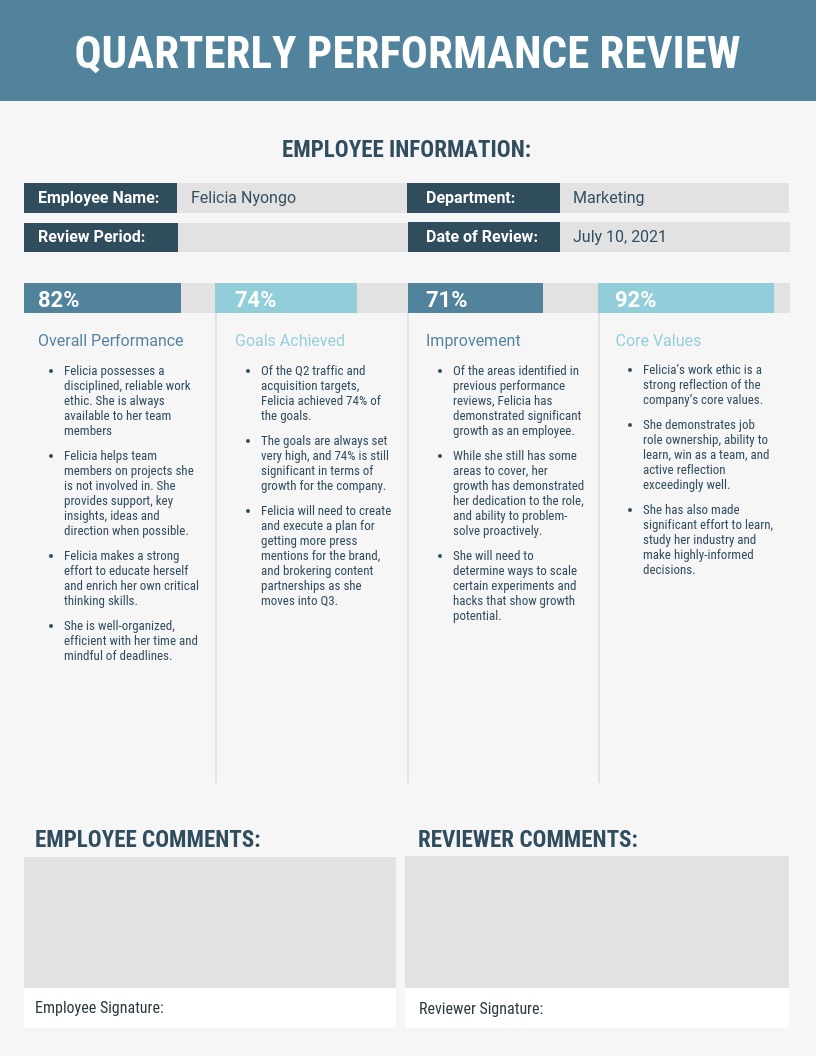
Performance reviews are structured evaluations where managers and employees discuss achievements, challenges and growth opportunities. Done well, they align personal performance with company goals—and build trust along the way.
But if we’re being honest: they often feel repetitive, unclear and awkward.
In this guide, you’ll get step-by-step writing tips, 50+ sample phrases, customizable HR templates and answers to common questions—plus my go-to trick for making reviews smoother: Venngage’s free Online Performance Review Generator.
Performance review example phrases
Struggling with what to say during performance reviews? The right phrases can help reinforce positive behavior, address areas of growth, and foster meaningful development. Below are categorized examples for managers, employees, and self-evaluations.
Sample performance review phrases (positive, development, skill-specific)
1. Positive-attitude & strengths phrases
Manager-focused examples
- She maintains a culture of transparency in her team and encourages knowledge-sharing across departments.
- He consistently provides reports with the training and resources needed to meet their goals.
- She is skillful in communicating difficult decisions and messages to her team.
Employee-focused examples
- You embody a “win together, lose together” philosophy that boosts team morale.
- Your ability to reflect, plan, and act is key to your excellent performance.
- You demonstrate strong ownership of tasks and follow through reliably.
Self-evaluation examples
- I generated five new leads and, as a result, exceeded my sales quota by 20%.
- I consistently met my project deadlines and supported colleagues when needed.
- I wrote a blog post based on original research that doubled our organic traffic in June.
2. Development & constructive feedback phrases
Manager-focused examples
- She tends to be risk-averse and prefers traditional approaches to creative ones.
- He is biased and openly favors some employees over others on his team.
- She creates chaos and miscommunication by delivering different messages to different team members.
Employee-focused examples
- He excels when working alone but has trouble collaborating with a team.
- She consistently focuses on lower-value work instead of high-leverage activities.
- He uses his seniority to try to dominate or intimidate team members.
Self-evaluation examples
- I recognize that I need to form new content partnerships. I plan to do so in Q3 by creating a list of 10 potential targets.
- I’ve noticed I tend to delay seeking clarification, which sometimes slows progress. I aim to be more proactive in Q4.
- I could better manage my time during peak periods and will begin tracking tasks more closely.
3. Skill-specific phrases (communication, leadership, etc.)
Manager-focused examples
- She replies to calls, emails, and messages promptly, often within 24 hours.
- He has a talent for thinking outside the box and presenting innovative solutions.
- She clearly outlines team goals and provides regular check-ins to ensure alignment.
Employee-focused examples
- Can you tell me more about what you mean?
- I want to be sure I understand your expectations before I proceed.
- What would I need to do to score higher on this next time?
Self-evaluation examples
- I presented a new workflow that improved our onboarding process and reduced confusion.
- I actively participated in team meetings, offered feedback and helped troubleshoot challenges.
- I’ve improved my communication by summarizing key action items after every meeting.
Sample comments by rating (5/5, 4/5, 3/5, needs improvement)
Not every employee fits neatly into the same box, and your feedback shouldn’t either. Whether you’re recognizing standout performance or offering gentle redirection, these sample review comments can help you strike the right tone while keeping things specific, actionable and fair.
If you need help identifying strengths, weaknesses and development areas before writing reviews, a SWOT analysis template is a simple way to organize your thoughts.
Here’s how you might phrase a review based on a typical performance rating:
5/5 – Exceptional Performer Comment
You’ve gone above and beyond in your role this cycle. Your leadership on the Q2 product launch, attention to detail and willingness to step up when the team needed support didn’t go unnoticed. You’re not just hitting goals but also helping shape team culture. Looking ahead, I’d love to see you lead a cross-functional initiative. You’ve clearly shown you’re ready.
4/5 – Above-Average Performer Comment
You’ve delivered consistently strong work and shown initiative in both team projects and individual goals. I appreciate how you ask smart questions, follow through, and offer support to newer teammates. One area to grow? Strategic thinking—looking ahead and identifying how your work connects to broader business goals. With that, you’re well on your way to the next level.
3/5 – Satisfactory Performer Comment
You’ve met expectations across your core responsibilities, on-time deliverables, quality work and a solid level of dependability. To grow from “Meets” to “Exceeds,” let’s work on being more proactive with communication. For example, during a couple of recent client demos, a few key slides needed stronger clarity. I’d recommend joining our “Presentation & Storytelling” workshop this quarter, it’s a great next step.
1–2/5 – Needs Improvement Comment
This review period highlighted a few areas that need attention. Missed deadlines and inconsistent communication have impacted the team’s momentum. That said, I believe with the right support and structure, we can turn this around. Let’s set biweekly check-ins and establish short-term goals to track progress. I’m here to help, your success is important to both of us.
What is a performance review?
A performance review is a regulated assessment in which managers evaluate an employee’s work performance to identify their strengths and weaknesses, offer feedback and assist with goal setting.
The frequency and depth of the review process may vary by company, based on company size and goals of the evaluations. It could be annually:

Or quarterly, to name a few:

This quarterly performance review example has sections for both achievements and areas of improvement. It also has a section for core values, as this must be a key performance indicator at this company. Different companies will have different measuring sticks for success.

Performance review templates
To conduct an effective performance review, it’s important to deliver a positive and solution-focused message. This will be less discouraging to the employee. This will be less discouraging to the employee and helps when publishing performance-related reviews on website or internal dashboards.
Below performance review template shows how you can offer constructive feedback, while also praising the employee’s efforts. The majority of the sections focus on the employees’ achievements and strengths.
Suggested areas of improvement are positioned in the middle, letting managers cushion criticism with praise.

This appraisal example shows how managers can give constructive feedback to their employees by giving them clear direction on what things to keep doing and what actions to take in future.
In the hypothetical example, Felicia did not meet her goal, her manager acknowledges that the goal was set deliberately high and that 74 percent of the goal still has significant impact.
This employee review form also points to specific positive behavior, such as self-education, teamwork and a strong work ethic.
There are also specific recommendations for improvement, such as putting together a plan to get more press mentions and scaling her experiments.

Another way to do a performance review, or kick off the process, is to use a quadrant. Both the employee and manager can plot where they think the former falls on certain key values and build out discussion points from there.
You can change “get it done/get it right” in the employee review template below to “uphold core values/contribute to company culture” for example.
Performance review template for managers
Performance reviews are a crucial part of effective management, offering an opportunity to provide constructive feedback and set the stage for future growth. Recognizing achievements during these reviews with employee recognition software can reinforce positive behaviors and motivate employees to continually improve.
To conduct a successful performance review as a manager, preparation is essential. Collect and review performance data well in advance, considering both quantitative metrics and qualitative observations.
Make sure to prioritize clear and open communication. Create a comfortable and respectful environment for the discussion, allowing the employee to share their perspective and concerns.
Offering specific examples of both strengths and areas for improvement is critical, as vague feedback can lead to misunderstandings.

Additionally, focus on setting SMART (Specific, Measurable, Achievable, Relevant, and Time-bound) goals for the future, collaboratively establishing an action plan that aligns with the company’s objectives and the employee’s career aspirations.

Finally, follow up on the action plan throughout the year, providing ongoing support and feedback to ensure continuous improvement. Consistent and well-structured performance reviews contribute to employee development, job satisfaction, and overall team success.
Performance review template for new employees
Performance reviews for new employees are critical in setting the tone for their growth and integration into the organization.
For new employees especially, they may be nervous or unsure of what to expect for their first performance review. That’s why, it’s important for managers to create a welcoming and comfortable environment.
Start by acknowledging their achievements and progress since joining the company. Recognizing their early contributions can boost their confidence and motivation.
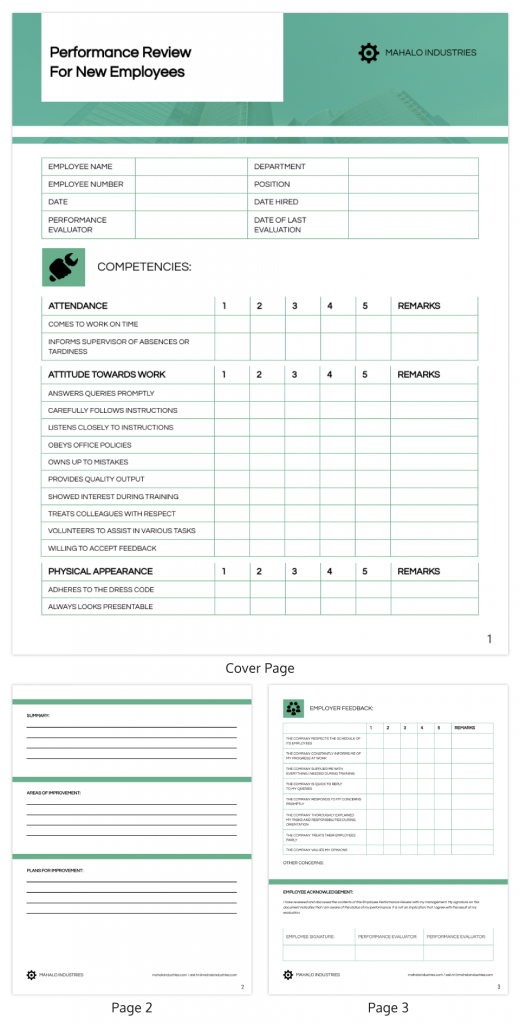
Additionally, focus on clear communication. Outline expectations and performance standards specific to their role. New employees should leave the review with a clear understanding of their job responsibilities and how their work aligns with the company’s goals.
It’s also crucial to discuss their career development. New employees often seek opportunities for advancement and growth. Use the review to explore their long-term goals within the company, and explain how their role fits into the larger career path.
Finally, emphasize ongoing support and mentorship. New employees benefit from regular check-ins and guidance to help them acclimate and succeed in their roles.
Simple performance review templates
Simple employee review
This below template uses quadrants to see how employee and manager evaluations match. Or only use it for self-assessments or manager assessments.
Simple performance review
The below template is more traditional performance review template focuses only on big categories, like meeting goals, areas of excellence and areas of improvement.

Simple employee review form
The below form is an even more condensed version of the above. Use it for a quarterly review to keep things focused or even for an annual review to help you and your report stick to the most important points. Change the text to include your own categories of evaluation.
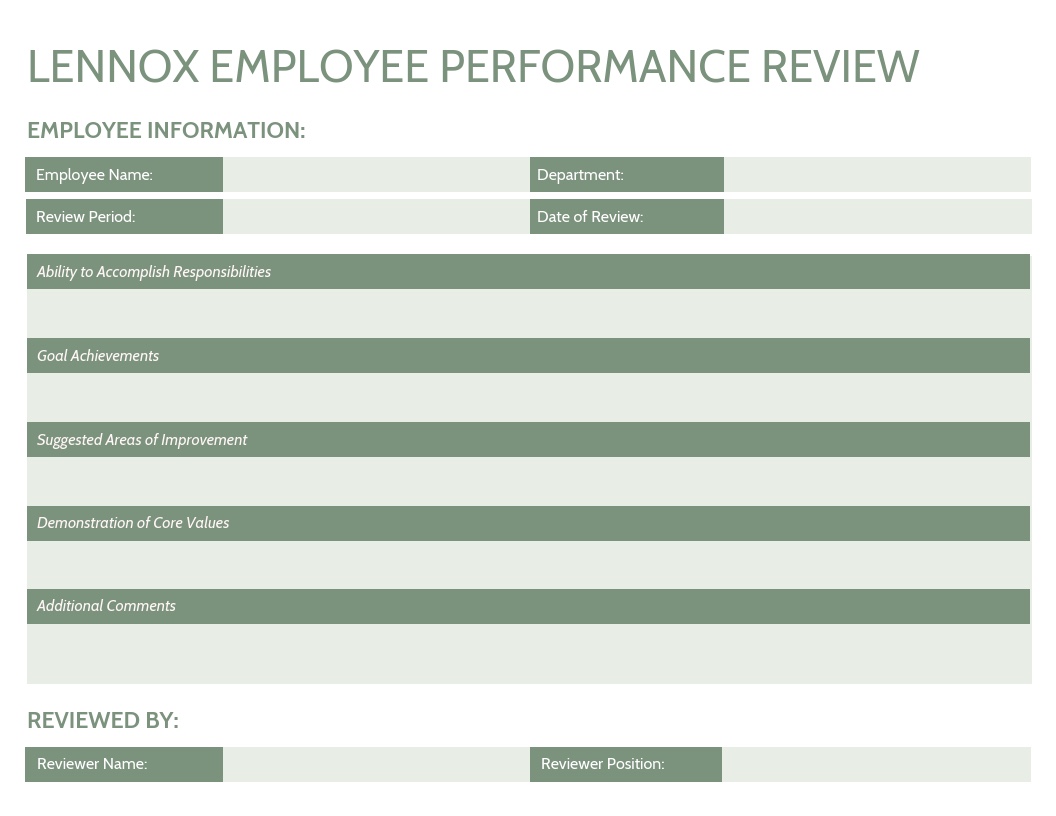
Self performance review templates
In a self-performance review, employees assess themselves using the same rubric as their managers would and submit them to HR and/or their manager prior to their official review meeting.
The benefits of doing self-assessments have made them a common part of the employee review throughout many companies.
Self-assessments are an encouraging opportunity for employees to share their thoughts about their job, goals, desired responsibilities and aspects of either their role or environment that they may be struggling with.
Set employees up for success in the self-assessment process by giving them a robust employee evaluation form with thoughtful questions, and HR tools like Workvivo to automate this process and make it more convenient.
Annual self-evaluation employee review
This first example is perfect for a thorough annual review. The targeted questions prompt the employee to reflect on their achievements and shortcomings, while also rating themselves on specific skill sets required for their job.

The above employee self-assessment example allows for multiple sign-offs, plus a section to list colleagues who can back up the employee’s statements.
Yearly performance self-evaluation
A yearly performance self-evaluation is a great chance for employees to assess their past performance.
It’s also a way for employees to plan for their professional future as they can see where their strengths lie and what skills they need to build to move up in the company. An annual self-evaluation can also build an employee’s case for their compensation review.
This employee self-evaluation form is broken into sections that cover all these factors: about your job, achievements, goals and professional development.

Below yearly performance self-evaluation template has space to expand on goals met and alignment with core values, as well as skills they’d like to build in the future:
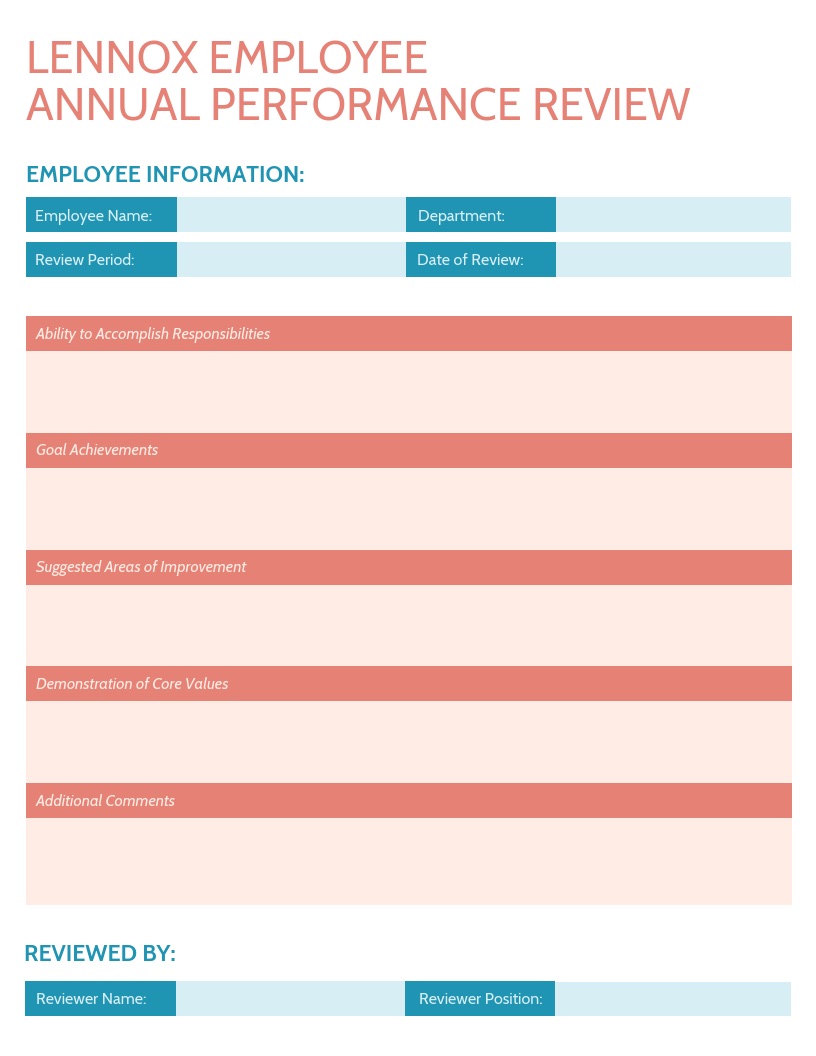
Self-assessment employee review forms
Many performance reviews are incredibly detailed. Sometimes, a higher-level overview is all that’s needed.
Quadrant evaluations, like the template below, are a great way for employees to do an assessment and for managers to quickly add their own evaluation, without getting into the weeds.
Employees can add what’s being evaluated in the easy-to-edit template below (instead of get it done/do it right). The employee adds an icon where they think they fall in the quadrant, and the manager does the same, with room on the last page to further break down the evaluation.
Sounds tough? Our real-time collaboration feature (part of the Business Plan) lets both manager and employee work on the same doc online, leave comments, share private links and more.

The self employee review form below lets the employee write out their job description. That way, they can reference their deliverables in the Goals Achieved and Areas of Excellence sections and directly demonstrate their impact on the organization:

This self-performance review example gives employees the chance to reflect on their achievements on a quarterly basis.
This way, employees can demonstrate meeting quarterly goals. It can also give them a chance to reflect on their strengths and weaknesses and have a chance to act on them before their big annual review:

Self-assessments also help enlighten managers of how employees understand their place within the company’s organization and culture.
The information disclosed in self-assessments should serve as a major element of official performance reviews in order to ensure that both a two-way conversation occurs and that the needs of both parties are being met moving forward. Looking for a better way to enhance employee engagement, to avoid quite boring meetings? Try out the top inspiring games for virtual meetings, to learn how to add a live poll, word cloud, spinner wheel or even live Q&A sessions to elevate your presentation!
To make for the most effective self-assessments, employees should be sure to consider how their managers’ perceptions of their performance varies from their own.
With this in mind, the information shared in a self-assessment can guide or pivot a manager’s perception and assessment of an employee’s performance.
Quarterly employee performance review templates
Quarterly reviews are important because they provide multiple opportunities for employees to receive helpful feedback on how to improve as the year progresses.
This quarterly performance review example reflects on specific areas of improvement, such as scaling her experiments and developing content partnerships.
Quarterly reviews from Q1 to Q3 serve as a means of providing specific, deliberate feedback to employees so they know exactly how to improve on their goals and skills.
This enables the final, annual evaluation conducted at the end of Q4 to serve as a final assessment that will have the most weight in determining how the employee will excel into the next year, discretionary bonuses, salary increases, etc.
Quarterly reviews offer a documented and tracked record of an employee’s progress throughout the year.
This means that each quarter should be assessed using the same rubric throughout the entire year. This will aid in ensuring an accurate representation of an employee’s development is recorded.
That means, if you use the below employee review template in Q1, you should also use it again in Q2 and Q3:
This quarterly performance review template is a more condensed version of the example above.
If you’d like to keep your quarterly reviews short and to the point, this template will suffice. Employers can then use the expanded version above for their annual review.

If you want a template that’s filled with useful information on the types of performance review phrases you can use for a quarterly review, you can edit the one below:

Annual performance review templates
At large organizations, there may not be enough resources in order to devote the time needed to conduct quarterly performance reviews for every employee.
This is also true in the case of a supervisor who has a large number of direct reports working for them whereby time management is their main issue.
In these situations, an annual performance review would work best, especially if the employees being evaluated are experienced in their line of work and have been with their company for a long time.
In this employee review template, staff are evaluated on only four factors: ability, goals, areas of improvement, and core values:

Annual evaluations are typically geared towards determining employee raises and discretionary bonuses.
Regular one-on-one meetings between direct reports and managers throughout the course of the year would be a great way to supplement this process.
Below annual performance review template can simply include scores (out of 100 etc.) in each box. Or put notes in each section to explain the overall performance score.

This being said, annual appraisals would need to take a more general approach to evaluating employees than just providing a summary of their performance over the year.
The following employee review template takes a graphic approach and neatly summarizes overall performance using a score out of 100 for factors such as adaptability and project quality:
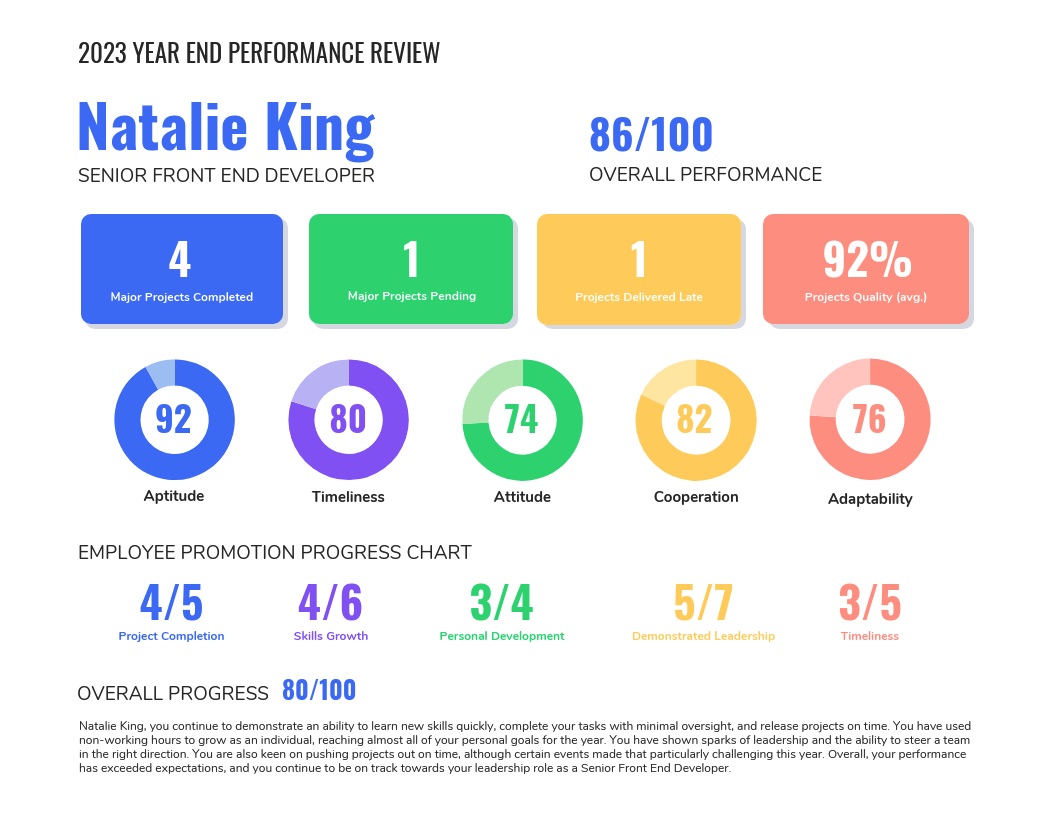
30-day performance review template
This is an early check-in, ideal for new hires. It helps you gauge how they’re settling in, what they’ve picked up so far and where they might still need support. It’s also a chance to clarify expectations and make sure onboarding is on track.
Template:
- Employee Name:
- Position:
- Review Period: First 30 Days
- Manager Name:
Sections:
- Initial Impressions & Strengths
- Onboarding Progress
- Performance Highlights
- Opportunities for Improvement
- Next Steps & Goals for Next 30 Days
To streamline onboarding and training, use a training checklist to keep things consistent for new team members.
60-day performance review template
By the 60-day mark, new hires should be gaining confidence in their role. This review helps reinforce early wins, flag any recurring challenges and offer coaching before the formal 90-day milestone. It’s a midpoint pulse check that keeps growth on track.
Template:
- Employee Name:
- Position:
- Review Period: First 60 Days
- Manager Name:
Sections:
- Progress Since 30-Day Review
- Strengths Demonstrated
- Feedback from Peers/Stakeholders
- Areas to Improve Before 90 Days
- Goals & Expectations for the Next 30 Days
To keep growth aligned and structured beyond the 60-day mark, you can pair this template with a longer-term training plan template to help set clear development milestones.
How to write a performance review
Having an employee-friendly performance review process can not only make or break the development of your employees but also disrupt the relationship between managers and their reports.
Beyond creating a robust performance review strategy and performance review form, managers must also consider their delivery of the appraisals. Communicating a performance review effectively is the final touch to executing a constructive, celebratory and effective review process.

Based on my involvement in building out our own effective performance review process at Venngage, I suggest taking the following steps into consideration when constructing a performance review:
1. Set expectations early
Early in an employee’s career with a company, managers should communicate the details of their review process including the expectations. It should be included in your employee handbook, for example.
In this way, managers set and communicate clear expectations of the key job functions and competencies of the role when an employee joins the company. The information presented in performance reviews should align with this define as well as use familiar language and terms. This strategy will work to eliminate any potential confusion or surprises for both parties.
2. Don’t make it personal
Feedback is about actions and behavior, not the person.
When writing a performance review, it helps to take a look at the issue(s) you’ve included and ensure that they apply to actions and behavior of the employee rather than the personal attributes of said employee.
This will also help to regulate the information mentioned in the review, to guarantee it is relevant and appropriate information.
3. Beware of biases and limitations
While there may be a general ‘right’ way of doing things, there are often multiple — and equally good — ways to reach the same end goal.
Please ensure your review is not biased or limited in favor of your personal work style and beliefs. Try to consider the various aspects of the employees role and experience that may impact their decision to pursue alternative methods or working habits. Be empathetic towards these factors when writing your review.
4. Be specific
The information presented in the review should be task-focused, clear and to the point.
General comments will leave an employee feeling confused and in the dark as to what aspect of their work needs to be corrected or how they can pursue improvements.
Failing to be direct in your messaging will impact the way your message is received and create further confusion about what the expectations are. Managers should be specific on what behaviors of their employees they are celebrating and what actions require improvements.
4. Offer guidance
Managers play a critical role in understanding the career goals of their employees and crafting development opportunities to help their reports achieve their goals.
It is important as a manager to offer your advice and expertise to your employees to help further their development.
If, as a result of the feedback given, the employee (or yourself) may feel as though they need additional training, consider the benefit of workshops, mentoring or coaching.
Be sure to use performance reviews as a way to guide employees whether it is toward further greatness or for areas requiring some improvement. Use performance reviews as an opportunity to improve and innovate over time. Consider creative approaches like using a QR code for reviews to gather feedback from customers dynamically and efficiently, thus enhancing both the employee evaluation process and the overall customer experience.
5. Follow up
Follow up in writing and check in continuously to ensure improvement.
Both managers and employees should receive a copy of the review to refer back to moving forward.
Whether reviews are scheduled annually or quarterly, they should be a continuous topic of discussion for both managers and employees. When writing a review, ensure that the review is clear and specific. Being mindful of this will help to ensure the employee can easily refer back to the form on their own after the meeting.

Watch this quick, 14-minute video for performance review tips, templates and best practices:
Related: How to Write a Performance Review That Inspires Growth (With Examples & Templates
How to write your own self-evaluation
Writing your own self-evaluation gives you a chance to reflect on your wins, own up to challenges and share where you’d like to grow. It’s not just helpful for your manager, it’s a way to advocate for yourself with confidence and clarity.
Want your self-assessment to be more impactful? Use visual communication techniques like charts or diagrams to highlight achievements or patterns when sharing results.
Structure of a strong self-evaluation
Here’s a simple framework to follow:
- Achievements & impact
Share your top accomplishments and explain how they contributed to team or company goals. Include specific metrics or outcomes when possible. - Areas for growth or improvement
Be honest about what didn’t go as planned. Acknowledge challenges and explain what you’ve learned or how you’re addressing them. - Goals & next steps
Outline clear, actionable goals for the next review cycle. Show that you’re thinking ahead and taking responsibility for your growth.
Sample self-evaluation paragraphs
Achievements & impact
In Q2, I led a cross-functional team to launch our new onboarding process, reducing ramp-up time for new hires by 30%. I also redesigned the internal help guide, which led to a 45% drop in repeat support tickets. These projects helped improve employee experience and support team efficiency.
Areas for growth or improvement
While I met all deadlines this cycle, I recognize that my time management during high-volume weeks could improve. I sometimes prioritized urgent tasks over strategic ones. I’ve started using weekly planning blocks to ensure long-term projects get the focus they need.
Goals & next steps
Over the next quarter, I’d like to strengthen my public speaking skills to lead more client presentations confidently. I plan to join the internal “Presentation Mastery” group and schedule one-on-one coaching sessions. This will help me contribute more in external-facing initiatives.
What should a performance review assess?
A typical performance review usually assesses several key areas of an employee’s performance, including:
- Overall job performance and quality of work
- Dependability and their ability to achieve goals
- Communication skills
- Teamwork and collaboration
- Attendance, punctuality and reliability
- Leadership and management (if applicable)
A review should also take into account:
- Employee development: Highlighting an employees’ developments are a powerful way to impact employee engagement and boost overall team performance.
- Company culture and values: Dedicate a section of the assessment to evaluate how employees align with the company’s core values thus contributing to a positive company culture.

Best practices & common pitfalls
Performance reviews aren’t just about checking a box—they’re an opportunity to support real growth and alignment. In fact, 74% of millennials say they feel “in the dark” about their work performance and how they could improve. Clear, timely feedback makes a huge difference.
Here are a few tried-and-true practices to follow, plus some common traps to avoid.
And if you’re thinking long-term, performance reviews are a great starting point for succession planning, especially when identifying high-potential employees and future leaders.
Best practices
- Be specific and cite data
Vague feedback doesn’t help anyone. Support your points with concrete examples, metrics or outcomes. - Use the SBI model (Situation, Behavior, Impact)
This framework helps structure feedback clearly. Describe the situation, explain the behavior and highlight its impact. It keeps the review grounded in facts, not opinions. - Tie feedback to company goals
Show how the employee’s work connects to larger business objectives. This reinforces purpose and helps everyone feel aligned. - Schedule follow-up
One conversation isn’t enough. Set a follow-up date to revisit goals and check in on progress, it shows commitment and builds trust.
Common Pitfalls to Avoid
- Vague language with no examples
Saying “you need to improve” without context leaves employees confused and discouraged. Be clear about what, why, and how. - Offering criticism without next steps
Constructive feedback needs to come with action plans. Otherwise, it feels like a dead end. - Skipping self-evaluation
Self-reflection helps employees take ownership of their growth and gives you insights into how they see their own performance. - One-time review with no follow-up
Annual reviews aren’t enough. Without regular feedback loops, progress stalls and goals drift.
Performance review FAQs
What’s the difference between a performance review and a performance appraisal?
A performance review is the conversation between a manager and employee about job performance. A performance appraisal is the formal evaluation, often with ratings or written summaries used to document that performance.
How often should companies conduct performance reviews?
Most companies conduct reviews annually or quarterly. Frequent, lightweight check-ins (like monthly or biweekly) can also boost engagement and keep goals on track between formal reviews.
Create a performance review strategy before writing an employee’s review
Having an employee-friendly performance review process can not only make or break the development of your employees and but also disrupt the relationship between managers and their reports.
That’s why it’s crucial to create a robust performance review strategy and employee evaluation form before implementation to ensure the process is both constructive, celebratory and effective. This will even help you in the future if you choose to write a letter of recommendation for the employee as you’ll have all his performance reviews to reference.
By considering the six steps above when writing a performance review, you’ll have completed the final step in executing an employee-friendly review process.
The satisfaction gained from an increase in employee engagement and people power will make the effort expended on administering performance reviews entirely worthwhile, and ensure you have more effective reviews moving forward.
Take notes of the effective performance review phrases you can use during any of review sessions, as well as creating a visually appealing assessment using Venngage performance review templates. It’s free to get started.
You might also like:





























